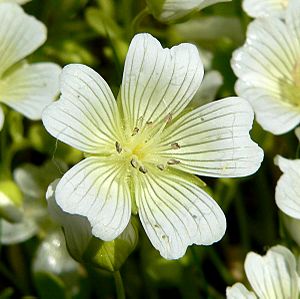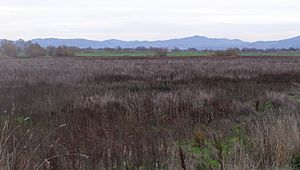Sebastopol meadowfoam facts for kids
Quick facts for kids Sebastopol meadowfoam |
|
|---|---|
 |
|
| Conservation status | |
| Scientific classification | |
| Genus: |
Limnanthes
|
| Species: |
vinculans
|
The Sebastopol meadowfoam (Limnanthes vinculans) is a special and rare wild flower. It is an endangered species, which means it is at risk of disappearing forever. This plant grows only in a small area of Sonoma County, California, in the United States. You can find it near the Laguna de Santa Rosa and some nearby creeks. Its scientific name, vinculans, comes from a Latin word meaning "linking" or "bonding." This refers to how it shares some features with other meadowfoam plants.
Contents
What is Sebastopol Meadowfoam?
Like other meadowfoam plants, Limnanthes vinculans is a small plant that lives for only one year. It is an herb, which means it has soft stems, not woody ones like a tree. Its stems can grow up to about 30 centimeters (12 inches) tall.
This plant has pretty white flowers that grow one by one at the end of each stem. The flowers are small, about 12 to 18 millimeters wide. They usually look like a bowl and bloom in April and May.
Unique Leaves
What makes Sebastopol meadowfoam special are its leaves. It is the only plant in its group that has "compound leaves." This means each leaf is made up of three to five smaller parts called "leaflets." Each leaflet is long and narrow, shaped like an upside-down egg.
When the plant is young, its leaves are simple and undivided. But as it grows, the mature plant develops these unique leaflets along a long stalk. This special leaf shape helps tell Sebastopol meadowfoam apart from other meadowfoam plants. After the flowers, the plant produces small, nut-like fruits called nutlets.
Where Does it Live?
The Sebastopol meadowfoam is very rare because it grows in only about 30 places. All these places are in Sonoma County, California. You can find it in wet meadows and around special puddles called vernal pools. These areas are always less than 300 meters (about 980 feet) above sea level.

Its homes are found from Graton to the areas around Sebastopol and east to Santa Rosa. It mostly lives in vernal pools, which are temporary ponds that fill with water in winter and spring. These pools dry up in the summer. The plant prefers wet soils and often grows near other endangered plants like Burke's goldfields and Sonoma sunshine.
Protecting the Plant
The Sebastopol meadowfoam is an endangered species, which means it needs special help to survive. It was first listed as an endangered plant by the state of California in 1979. Then, in 1991, the U.S. government also listed it as federally endangered.
Conservation Efforts
Both the state and U.S. governments are working with local cities like Sebastopol and Santa Rosa. They look at plans for new buildings in areas where the plant might live. Their goal is to protect the plant's habitat. Sometimes, they might ask builders to protect the plant where it grows (called In situ conservation). Other times, they might ask to move the plants to a safe place (called Ex-situ conservation).
A main way to protect the plant is through programs that save and restore vernal pools. These programs help make sure the plant has a place to live and grow.
Threats to its Home
The Sebastopol meadowfoam's home is threatened by human activities, especially new buildings and towns growing bigger. In 2005, there was a discussion about the plant at a planned building site in Sebastopol. Some people thought the plants were moved there on purpose to stop the building project. State officials investigated and ordered the plants to be removed. However, others disagreed, saying the plants were naturally there. Even though the plants were removed, they grew back the next year from seeds. Local officials are still deciding what to do about the building project. The main goal is to find ways for people and this special plant to live together.


